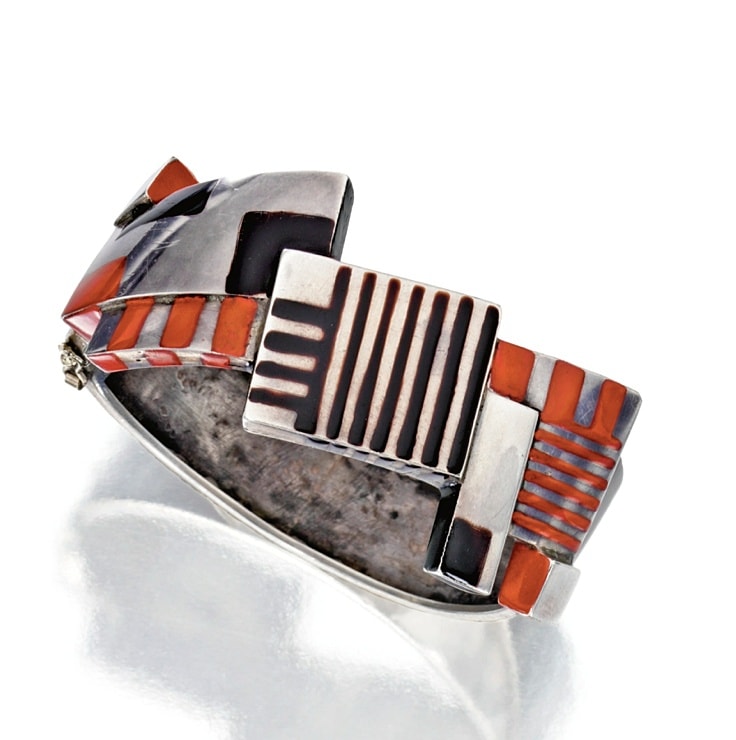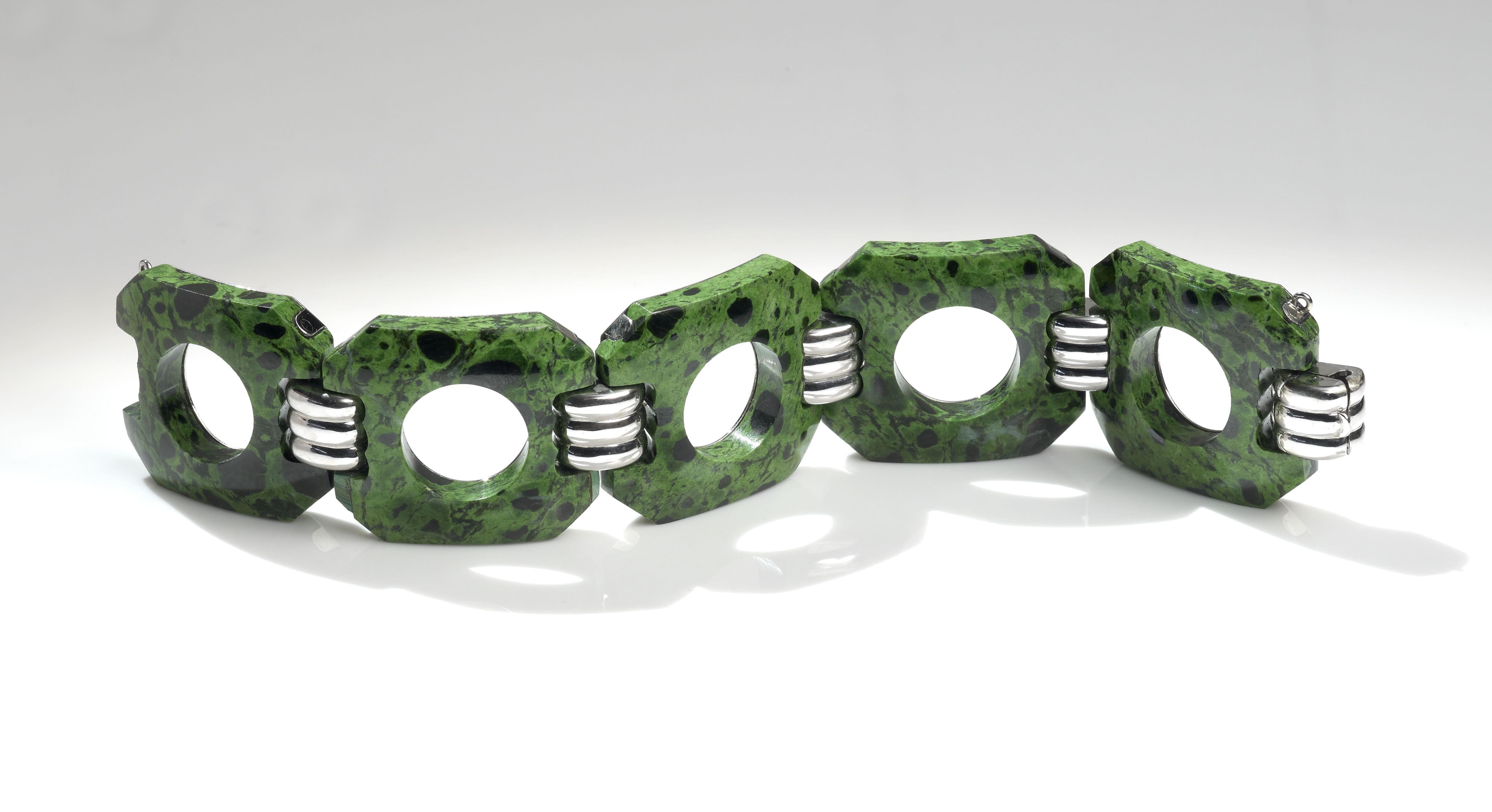
THE EXPOSITION INTERNATIONALE DES ARTS DÉCORATIFS ET INDUSTRIELS MODERNES
The name “Art Deco” stems from one of the most culturally motivating events of the 1920s, the Exposition Internationale des Arts Décoratifs et Industriels Modernes (International Exhibition of Modern Decorative and Industrial Arts), which took place from April to October 1925 in Paris, France.

This massive exhibition completely modernized all forms of style. Ideas stemming from cultures across the globe collided to set the course for architecture, art, fashion and jewelry, among other things.
WHAT IS ART DECO?
Art Deco, a term which became widely used and accepted in the 1960s, is a period of time influenced by the free-flowing elegance of Art Nouveau, the geometric simplicity of cubism, the complexity of the machine age and the human practicality brought about by the devastation from the first World War.
Art Deco artists took inspiration from the advances in industry all around them, incorporating ideas such as the wings of an airplane, the bow of a yacht, an automobile engine or the cogs and wheels of a sewing machine. Concepts were generally based around geometric shapes and symmetry. When lines were used, they did not swirl like those of the Art Nouveau period; they were straight and angled or they curved in a gradual and sweeping manner.
The Art Deco period is perhaps most completely described by Bevis Hillier in her 1968 book, Art Deco of the 20s and 30s, “…an assertively modern style, developing in the 1920s and reaching its high point in the thirties, it drew inspiration from various sources, including the more austere side of Art Nouveau, cubism, the Russian Ballet, American Indian art, and Bauhaus; it was a classical style in that, like neo-classicism but unlike Rococo or Art Nouveau, it ran to symmetry rather than asymmetry, and to the rectilinear rather than the curvilinear, it responded to the demands of the machine and of new materials such as plastics, ferrocrete and vita-glass, and its ultimate aim was to end the old conflict between art and industry, the old snobbish distinction between artist and artisan, party by making artists adept at crafts, but still more by adapting design to the requirements of mass-production.”
CHANGES IN OVERALL FASHION
At the beginning of the twentieth century, the world experienced total war like never before. People on every inhabited continent were affected by the devastation and their lives adapted accordingly. Women were entering the work force and taking on the responsibilities previously held by the men fighting in Europe. When the war ended, the men returned, but the women of the age took pride in their newly acquired skills and dressed to take on the world, completely evolved from the delicate creatures of the early 1900s.
When the war ended, many women decided to keep their new jobs, and these newly matured women demanded more practical fashion options. Long skirts, constricting bodices and elaborate hairstyles were abandoned in favor of shorter dresses and cropped hairstyles, which enabled women to easily perform their new responsibilities.
For the first time in history, women’s fashion was completely opposite depending on the time of the day. Trousers became the symbol for a liberated woman’s daywear, but she still wanted her evening wear to remain sexy and dramatic. The short skirts and trousers worn during the day were abandoned at night in favor of long sleeveless tunics with low-cut backs which elegantly revealed the natural curves of the female body. Referred to as the Pablo Picasso of fashion, Paul Poiret, motivated change by dropping the waistline to the hips and opened up women’s skirts with slits that would allow them to move freely and enjoy the new dances of the time, such as the Charleston, Tango and Foxtrot.

The 1920s also marked the beginning for fashion icon Coco Chanel, who in the late 20’s launched a sporty, yet elegant line of fashion, including two-piece suits which became an indispensable garment for all fashionable women.
Fashion trends were more restrained in the 1930s as the waistline returned to a more natural position, and the loose, shapeless tops were substituted for more feminine garments, designed to enhance the natural lines of the female body. For daywear, Chanel’s tailored suits remained the new standard and evening wear consisted of long dresses and shawls of satin and silk, which were decorated with brooches and tightly embraced the female figure.
ART DECO JEWELRY CHANGES TO ACCOMMODATE NEW FASHION TRENDS
The large floral brooches and constricting dog collar necklaces were not practical accessories for the modern, emancipated woman.
While clothing was cut back and comfortable, the average woman of the 1920s covered herself with stacks of bracelets and elegant rings. The open back dresses popular at the time introduced the idea of a backlace, a necklace worn down the back rather than the front, decorated with a pendant on the clasp. At night, women decorated their hair with a bandeau, often set with semi-precious stones or decorated with gem-set brooches.
Jewelry patterns developed more geometrical and linear designs and vivid outbursts of primary colors were more common than the white, black and pastel jewelry of the early 1900s. Jewelry became an accessory designed to accentuate each individual outfit, instead of an ornament intended to display one’s wealth. It was not uncommon for wealthy women to design clothes around their favorite jewels or jewels around their favorite outfits. The wrist watch also came into popularity during the 1920s, thanks to tennis star, Suzanne Lenglen.
BIJOUTIERS-ARTISTES
At the 1925 Exposition Internationale des Arts Décoratifs et Industriels Modernes, jewelry was represented in the “Parure” class, grouped with clothing, accessories and perfumes. While the jewels exhibited shared some common themes, the jewelry designers can be further broken down into bijoutiers-artistes, the innovative, radical artist jewelers and the bijoutiers-joailliers, the moderate, well established fine jewelry houses.
Inspired more by their own creativity than intrinsic value, the bijoutiers-artistes used a combination of semi-precious stones such as aquamarine, citrine, topaz and amethyst. Carved coral, jade, lapis lazuli, onyx and rock crystal were common additions; diamonds were used sparingly, and precious colored stones were almost never used. The machine age had brought in new engraving and cutting techniques which allowed for gemstones to be cut into new shapes, often resembling works of art more than jewelry. Synthetic colored stones, a relatively recent discovery from a few decades before, were commonly used for decorating these pieces because natural inclusions make small stones incredibly difficult to cut into calibrated shapes.
The best known bijoutiers-artistes of the time were George and Jean Fouquet, Gérard Sandoz, Jean Després, Jean Dunand and Raymond Templier. Their obsession with modernism and cubism encouraged them to produce monumental pieces of jewelry: imposing bangles, large, sculpted rings and colossal pendants. Miniscule decoration was disregarded in favor of creative designs which could be appreciated from a distance.











BIJOUTIERS-JOALLIERS
The bijoutiers-joailliers, the famous Parisian jewelry houses, took advantage of new metals, machinery and trends in their work, but they were much more conservative in their transformation. They abandoned delicate designs in favor of bold pieces with sharp color contrast. The bijoutiers-joailliers primarily used diamonds, rubies, emeralds and sapphires, but some of their more innovative pieces incorporated collaborations of semi-precious stones including coral, jade, onyx and rock crystal. Their designs featured strong lines and were motivated by Persia, Egypt and the Far East, borrowing themes from these civilizations in many of their designs.











the egyptian revival
In November 1922, a team of archaeologists uncovered one of the most important finds of the twentieth century: the tomb of King Tutenkhamen (King Tut) in the Valley of the Kings in Egypt. The quartz sarcophagus revealed a young pharaoh decorated with gold pectoral plates, armlets, diadem, rings and of course his famous gold mask. The tomb soon became a top international travel destination, and Egyptian culture became one of the most common sources for inspiration for the figurative arts, literature, fashion, film and jewelry design.
Ancient Egypt provided a multitude of inspirational motifs: pyramids, sphinxes, obelisks, palmettes, lotus flowers, scarabs, hieroglyphs, imitations of hieroglyphs and numerous Ancient Egyptian dieties, commonly known for appearing as part human and part animal. The bright contrast in color and sharp lines made Egyptian art a well suited fit for an Art Deco revival. Design houses such as Cartier, Boucheron and Van Cleef and Arpels designed many pieces which fit in to this motif.
how the stock market crash of 1929 effected jewelry and fashion
The stock market crash of 1929 is widely considered one of the most catastrophic events of the 20th century. This drastic economic change shifted the effervescent spirited people of the 1920s into a mindset focused on moderation and responsibility. Consequentially, fashion changed dramatically. The short, straight lines from dresses were substituted by more feminine garments made from soft, shiny materials.
Surprisingly, the overall jewelry industry was relatively unaffected, especially when compared to other industries. Rather than moving towards feminine, delicate and lower priced jewels, popular jewelry became even bolder and larger. Bracelets were becoming even bulkier than they were in the 1920s, and the trend of stacking them remained popular. The pendant style earrings popular in the previous decade were replaced by large clip on earrings that covered the entire ear lobe.
Popular jewelry fashion trends may not have been affected by the stock market crash, but the quantity of people capable of purchasing the jewelry certainly did. This is one of the reasons that Art Deco jewelry is so rare.
the 1930's - "the white period"
In contrast to the colorful early Art Deco period of the 1920s, the early 1930’s became the “white period”, commonly using diamonds and white gold or platinum. The unique gemstone combinations of the 1920s were replaced by pave-set diamonds, often cut into unique shapes. Color was used more sparingly to accent the diamonds, rather than stealing the focus. The use of large precious, semi-precious and hard stones for rings continued, but the designs were much simpler and focused on the uniqueness of the cuts of the stones.

new shapes for stones
The advancements of the machine age gave many artists the luxury of creating custom, never before used cuts for gemstones to fit into their own jewelry designs. Trapezoids, semi-circles, half-moons, barrels, triangles and prisms all made their first appearances in jewelry during the 1920s. The Egyptian revival introduced a need for carved calibre cut colored stones for intricate floral and naturist designs.
the invention of white gold
The concept of turning gold white was first introduced in the late 1800s, and it became first commercially available in Germany in 1912. It was not until the mid-1920s however that it became a popular low-cost substitute for platinum. Gold is turned white by alloying it with metals such as nickel or zinc to dull the color, and it is coated in a thin layer of rhodium (a member of the platinum family of metals) to enhance the luster of the piece.
KIKICHI MIKIMOTO
One of the most influential contributions to the jewelry industry of the Art Deco period was the introduction and perfection of the process of culturing pearls, by Kikichi Mikimoto, the son of a Japanese noodle maker. Although his first patent for culturing pearls came in 1896, it took many years to perfect the art, and following his 1916 patent to produce round pearls, cultured pearls were introduced to the international market in 1921. By 1921, Mikimoto was not only producing more pearls than other suppliers, his pearls were more spherical, a better color and viewed as more desirable. The invention of cultured pearls allowed for women all over the world to afford this precious gem that was previously seen as a status symbol of only the elite.

